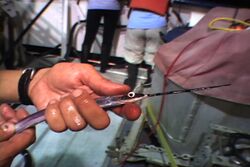Biology:Balao halfbeak
| Balao halfbeak | |
|---|---|

| |
| Scientific classification | |
| Domain: | Eukaryota |
| Kingdom: | Animalia |
| Phylum: | Chordata |
| Class: | Actinopterygii |
| Order: | Beloniformes |
| Family: | Hemiramphidae |
| Genus: | Hemiramphus |
| Species: | H. balao
|
| Binomial name | |
| Hemiramphus balao Lesueur, 1821
| |
| Synonyms | |
| |
The Balao halfbeak (Hemiramphus balao), occasionally called the Balao for short, is an ocean-going species of fish in the family Hemiramphidae. It was first described by the French naturalist Charles Alexandre Lesueur in 1821. They are used as cut bait and for trolling purposes by saltwater sportsmen.[2][3]
Description
The Balao halfbeak is similar in appearance to its relative the ballyhoo (H. brasiliensis). The main difference between the two is that the distance from the nares to the base of the pectoral fin is greater than the length of the ballyhoo's pectoral fin, while that difference is less than the length of the Balao halfbeak's pectoral fin[4] They have no spines on fins, but do have 11-15 rays of their dorsal fins and 10-13 rays on their anal fins.[4] Balao halfbeak have blue-gray skin on their backs,[4] while their undersides are silver or white. The longest recorded Balao halfbeak was 40 cm long.[5]
Distribution and habitat
Balao halfbeak are found only in the Atlantic Ocean. In the west, they are known from New York south to Brazil, including much of the Gulf of Mexico[6] and the Caribbean.[7] In the eastern Atlantic, they are known from the Canary Islands and the Gulf of Guinea from Victoria, Nigeria to Luanda, Angola.[8] Balao halfbeak have also been recorded from Côte d'Ivoire.[9]
Balao halfbeak can form fairly large schools where they feed on smaller fishes and zooplankton.[7] They can be found in both brackish and marine waters and are associated with reefs.[7][10][11] Although they are mainly used by humans as baitfish for sailfish and marlin, they are also used as food in the West Indies.[7] Balao halfbeak are also preyed upon by the brown noddy and the sooty tern.[4]
References
- ↑ Collette, B.; Polanco Fernandez, A.; Aiken, K.A. (2015). "Hemiramphus balao". IUCN Red List of Threatened Species 2015: e.T15521875A15603425. doi:10.2305/IUCN.UK.2015-4.RLTS.T15521875A15603425.en. https://www.iucnredlist.org/species/15521875/15603425. Retrieved 19 November 2021.
- ↑ McBride, Richard S., Lisa Foushee, and Behzad Mahmoudi. 1996. Florida's Halfbeak, "Hemiramphus" spp., Bait Fishery [1] Marine Fisheries Review. 58(1-2): 29-38.
- ↑ McBride, Richard S.. 2001. Landings, value, and fishing effort for halfbeaks, "Hemiramphus" spp., in the South Florida Lampara Net Fishery [2] Proceedings of the 52nd Gulf Caribbean Fisheries Institute. 52: 103-115.
- ↑ 4.0 4.1 4.2 4.3 Froese, Rainer and Pauly, Daniel, eds. (2009). "Hemiramphus balao" in FishBase. 06 2009 version.
- ↑ Collette, B.B. 1981 Hemiramphidae. In W. Fischer, G. Bianchi and W.B. Scott (eds.) FAO species identification sheets for fishery purposes. Eastern Central Atlantic (Fishing Areas 34, 47 (in part)). Volume 2. Department of Fisheries and Oceans Canada and FAO. Rome.
- ↑ Robins, C.R. and G.C. Ray 1986 A field guide to Atlantic coast fishes of North America. Houghton Mifflin Company, Boston, USA 354 p.
- ↑ 7.0 7.1 7.2 7.3 Collette, B.B. 1978 Hemiramphidae. In W. Fischer (ed.) FAO species identification sheets for fishery purposes. Western Central Atlantic (Fishing Area 31), Volume 2. FAO, Rome.
- ↑ Collette, B.B. and N.V. Parin 1990 Hemiramphidae. p. 579-582. In J.C. Quero, J.C. Hureau, C. Karrer, A. Post and L. Saldanha (eds.) Check-list of the fishes of the eastern tropical Atlantic" (CLOFETA). JNICT, Lisbon; SEI, Paris; and UNESCO, Paris. Vol. 2.
- ↑ Diouf, P.S. 1996 "Les peuplements de poissons des milieux estuariens de l'Afrique de l'Ouest: L'exemple de l'estuaire hyperhalin du Sine-Saloum". Université de Montpellier II. Thèses et Documents Microfiches No.156. ORSTOM, Paris. 267 p.
- ↑ McBride, Richard S., and Justin R. Styer. 2002. Species Composition, Catch Rates, and Size Structure of Fishes Captured in the South Florida Lampara Net Fishery Marine Fisheries Review. 64(1): 21-27.
- ↑ McBride, Richard S., Justin R. Styer, and Rob Hudson. 2003. Spawning cycles and habitats for ballyhoo (Hemiramphus brasiliensis) and balao (H. balao) in south Florida Fishery Bulletin 101:583–589.
McBride, Richard S., and Paul E. Thurman. 2003. Reproductive Biology of Hemiramphus brasiliensis and H. balao (Hemiramphidae): Maturation, Spawning Frequency, and Fecundity. Biol. Bull. 204: 57–67. [3]
External links
Wikidata ☰ Q2447753 entry
 |


